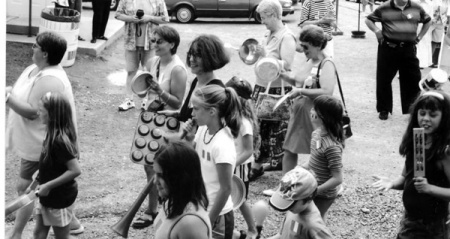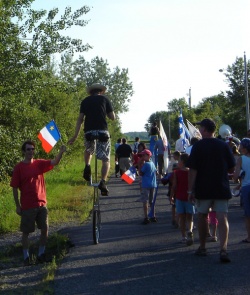Tintamarre: a New Acadian “Tradition”
par Labelle, Ronald
Every year on August 15th, on the occasion of the Acadian national holiday, Acadians from the Maritime provinces hold a Tintamarre, a grand celebration in which people get together and march through their communities making an enormous racket with improvised instruments, in order to express their pride in their Acadian heritage. This practice has become symbolic of their identity, along with the three-coloured flag and the hymn Ave Maris Stella. It is an important component of the image promoted of Acadia outside the Maritimes. While the other symbols of Acadia originated as a part of the growing self-awareness that emerged during the second half of the 19th century, Tintamarre is different in that it is a relatively new phenomenon, dating back only to the end of the 1970s.
Article disponible en français : Tintamarre, une nouvelle « tradition » en Acadie
The First Tintamarre in Caraquet in 1979
The first annual large-scale Tintamarre took place in Caraquet, New Brunswick. On August 15th, the main street of this small town, where the headquarters of various Acadian organizations are located, closes to traffic and fills with thousands of people wearing fanciful costumes and making a huge racket using improvised instruments. The Tintamarre celebration has taken on such proportions in Caraquet that even the premier of the province feels obliged to make an appearance. (NOTE 1) Now that thousands of tourists flock to Caraquet every year on August 15, the economic spin-offs from the holiday have also become considerable.
Any tourist arriving in Caraquet on August 15th would be left with the impression that Tintamarre is a tradition that is deeply rooted in the Acadian consciousness. And yet this annual "tradition" only dates back to 1979. That year the August 15th edition of the L'Évangéline newspaper sent out the following invitation to the public celebrations marking the 375th anniversary of Acadia:
Activities [...] will surely reach a high point at 6:00 p.m. sharp when the whole of Acadia will be filled with all kinds of sounds resulting from the tintamarre [clangor or din], also known as the charivari [shivaree]. All Acadians are invited to participate in the tintamarre in order to fill the air with every sort of noise: bells, horns, songs, shrieks, all kinds of noisy instruments, etc. The general hubbub will reflect the joy felt by Acadians and their solidarity on this the day of their national holiday."(NOTE 2)
In 1979, the ancient New Brunswick custom of the shivaree had not been forgotten and the idea of getting together to make a racket was thus familiar to Acadians. The charivari or chavari had always been a local event spontaneously organized as a tongue-in-cheek protest, most often during a wedding. On the other hand, the invitation to participate in a tintamarre was addressed to all Acadians and was intended to promote collective merrymaking.
The Origins of the Contemporary Celebration of Tintamarre: 1955
Another Tintamarre had taken place before 1979 and undoubtedly served as an inspiration for the 1979 version. The earlier event was held in 1955 in Moncton during the large-scale celebrations organized by the archdiocese to commemorate the 200th anniversary of the Acadian Deportation. (NOTE 3) Mgr Norbert Robichaud issued an official instruction sheet, from which the following excerpt is taken:
On Wednesday, August 7th at 7:00 p.m., the bells of all the churches will ring for two minutes to announce the official opening of the Acadian bicentennial celebrations. As soon as the bells start ringing, all families will kneel outside in front of their houses and recite the beautiful prayer of the bicentenary out loud. Once the prayer is finished, there will be a joyful tintamarre lasting for several minutes, featuring anything, everything and everyone that can make noise, shout and ring: mill whistles, car horns, bicycle bells, squawking objects, toys, etc.
The opening of the bicentennial celebrations that took place in front of the Notre-Dame-de-l'Assomption Cathedral in Moncton included speeches, prayers, marching bands, folk dances, church bells and a "tintamarre." Sirens, car horns, bells and all sorts of noisemakers echoed for five minutes during the opening ceremony.(NOTE 4) Approximately 5,000 people came to this first Tintamarre. Journalist and future politician, René Lévesque, attended the event and described it on the airwaves of Radio Canada:
Here in Moncton and in all of Acadia, it's time for the tintamarre. These are the sounds [the listeners to the radio program could also hear them] of the joyful tintamarre... that can be heard everywhere a descendant of those deported in 1755 can be found... There is also military music, featuring Moncton's Notre-Dame-de-l'Assomption Cathedral's brass band playing the sounds of a flourishing fanfare with its brass instruments. There are little children shouting... Listen!-It is the sound of is the heartbeat of French-speaking Acadia in 1955-two centuries after it was supposed to have been extinguished. (NOTE 5)
An Acadian "Tradition" Renewed for the 375th Anniversary Celebrations
There is no mention of tintamarre celebrations to be found anywhere in the years following 1955 until the 1979 celebration of the 375th anniversary of the founding of Acadia. On this occasion, it was the town of Caraquet that was the centre of the tintamarre celebration. This small municipality, located in the very heart of the Acadian Peninsula, plays an important role in the cultural life of region's French-speaking community, particularly because it is the site of the Acadian Historical Village, as well as the largest Acadian summer festival. Because Acadia had become more secular since the 1950s, the tintamarre celebration that took place in 1979 was no longer organized by the Catholic Church, but rather by the Société des Acadiens du Nouveau-Brunswick [New Brunswick Acadian Society] (SANB).
According to one of the main organizers, Georges Bourdages, the goal of the event was to encourage the Acadian people to "reaffirm their identity loud and clear" in a celebration open to all. (NOTE 6) The slogan of the 375th anniversary, on est venus c'est pour rester [we've come back and were here to stay], was proudly displayed on buttons, signs and stickers. The message circulated by the SANB was that Acadians could feel at home anywhere in New Brunswick. Bourdages insists that the project planners did not intend Caraquet to be the centre of the Tintamarre celebrations. The event was meant to take place at a key moment during the 375th celebration. Nobody expected that Tintamarre would quickly turn into a tradition.
The Tintamarre celebration has become an annual event, which is largely due to its resounding success in Caraquet in 1979. The following year, the SANB did not actively coordinate the August 15th celebrations, but Tintamarre celebrations were spontaneously organized on a number of locations anyway. In the L'Évangéline newspaper, the 1980 celebrations were described as "mini-tintamarres" that took place everywhere except in Shippagan and Caraquet where, for about an hour, large processions paraded through the communities, with participants sitting and standing in the backs of trucks banging on barrels using anything that made noise, while residents came out of their houses to bang on pots and pans. (NOTE 7)
In Caraquet, Tintamarre was quickly integrated into the Acadian Festival, which has been taking place since 1962, as a part of the festivities of the Acadian August 15th holiday. In 1981, during the one-hundredth anniversary celebrations of the Acadian national holiday, the main street of Caraquet was closed to traffic while a crowd of participants wearing Acadian colours marched through the village on foot. (NOTE 8) The following year, people began to wear costumes and to dress up for the occasion, and so more and more, Tintamarre began to take on the appearance of a carnival. (NOTE 9)
Tintamarre Spreads throughout Acadia
In 1982, various other communities of North-eastern New Brunswick followed suite and thus, Tintamarre spread throughout the region. Street carnivals are however not essentially a part of the Acadian way of life, and so, the Caraquet model was not imitated everywhere. In Moncton, for example, the 1982 Tintamarre was simply a procession of cars travelling along the route to the neighbouring city of Dieppe to the sounds of shouting and honking. (NOTE 10)
In 1984, on the occasion of the one-hundredth anniversary celebrations of the Acadian flag, a traditional tintamarre was already being discussed in the newspapers, even though this "tradition" had only existed for five years.(NOTE 11) Thereafter, laborious attempts were made to mobilize people in outlying regions whose Acadian identity is less visible. Places such as Campbellton, where, in 1987, barely 25 people came together to parade down the streets.(NOTE 12)
The number of people participating in the Caraquet Tintamarre has never stopped growing. In 2004, 30,000 people are said to have participated in the event in a small town whose total population still does not exceed 4,500 residents. Adding to the influx of tourists, people come from all over North-eastern New Brunswick for the August 15th celebrations. (NOTE 13) The organizers of the Acadian Festival award various prizes for Tintamarre costume creativity, in order to encourage participants to create original costumes. For example, in 2006, seven categories of prizes were given out, including the most beautiful hat and the best noisemakers. (NOTE 14)
Over the years, the Tintamarre custom has also made its way from the north of the province to the south. In Bouctouche, for example, a procession of pedestrians leaves downtown for its final destination, the Pays de la Sagouine tourist site, whereas in Cap-Pelé, the Tintamarre celebrations are restricted to a simple car parade. (NOTE 15) Since 2003, Moncton's main street has been closed to traffic on August 15th, so as to encourage the population to participate in the Tintamarre festivities, athough this has been met with only limited success. (NOTE 16) In the twin city of Dieppe, participation levels are higher, but the main feature of the Tintamarre celebrations here is a huge car parade as well. It seems to be more difficult to introduce the custom of holding an annual Tintamarre in the south of the province, where the majority of the population is English speaking and Acadians are still reluctant to display their identity.
There are also places where religious factors cause people to be more reticent about the new custom of Tintamarre. In Rogersville, the cradle of Acadia's Assumption Day festivities, (NOTE 17) open-air masses have been held at the National Monument of the Assumption to mark the national holiday since 1881, but no Tintamarre has been organized as of yet.
In Memramcook, one of the main centres of the Acadian Renaissance, Assumption Day has retained a solemn character and Tintamarre has not managed to take root. In Nova Scotia and on Prince Edward Island, Tintamarre is also having difficulty making inroads. In Pomquet, Nova Scotia, for example, tradition dictates that the August 15th celebrations culminate with a procession headed by a statue of the Holy Virgin. There is no room for street festivities of a jovial nature in Pomquet! On the other hand, the Acadian World Congress held in Nova Scotia in 2004 created a context that favoured the organizing of activities to celebrate Tintamarre on a number of locations.
The Role of Intellectuals in Establishing the "Tradition"
In an article on the August 15th holiday, Herménégilde Chiasson wrote that "Even today, if you ask elderly people what this date means for them, they will share their memories of religious celebrations and of the family reunions associated with them." (NOTE 18) In Caraquet, where the Tintamarre festivities have replaced the solemn mass as the main activity marking the August 15th holiday, one religious custom has nevertheless continued: the ringing of the parish church bells at 6:00 p.m. sharp to officially announce the start of the Tintamarre celebrations.
In another recent article, Herménégilde Chiasson made the following observation concerning the Tintamarre festivities: "By a strange twist, this event has been turned into a tradition and people are disappointed that they are unable to find any historical basis for it, but that will come." (NOTE 19) Although the direct historical antecedents remain undiscovered, the traditional character of Tintamarre is constantly being affirmed through references to customs such as the charivari or the firing of gunshots on New Year's Day. The organizers of the 1979 Tintamarre were certainly inspired by the custom of the shivaree, as it has already been suggested by the cited newspaper articles. That occasion was nevertheless an attempt to recover elements of a time-honoured tradition to use them in a new context. Nowadays it seems clear that the Tintamarre festivities are being associated with even older, more historical practices, a tendency that is largely due to a desire to believe that a people that has been in existence for more than 400 years must have retained some of their ancestral customs.
Thus, Tintamarre has quickly become one of the main symbols of Acadian identity. As early as 1992, the essayist Jean-Marie Nadeau supported such notions when he published his nationalistically-oriented Que le tintamarre commence: Lettre ouverte au peuple acadien [Let the Tintamarre Begin: an Open letter to the Acadian People]. (NOTE 20) From then on, whenever there has been an opportunity for people to affirm a sense of belonging to Acadia, the Tintamarre celebrations have been part of the equation, regardless of the location or the context. In September 2006, for example, a brief tintamarre was held to mark the inauguration of a new medical training program at the Université de Moncton; the explanation for the inclusion of the celebration in the program was that it was an "essentially Acadian custom".
The word tintamarre has become such a mainstay of everyday vocabulary that it is now an integral part of the way Acadians are seen outside the Maritimes. In Louisiana, since 1996, the Department of French Studies at Centenary College in Shreveport has been publishing a student journal entitled Le Tintamarre; the school also has a virtual library featuring literary works of Franco-Louisian origins, which they named the Bibliothèque Tintamarre. (NOTE 21)
The Province of Quebec has also jumped on the bandwagon, for, since 2001, the village of Saint-Liguori in Lanaudière - home to descendants of 18th-century Acadian refugees - has held its own Acadian festival, the Fête du Tintamarre. (NOTE 22) In 2004, the Quebec filmmaker André Gladu completed a feature-length movie celebrating the vitality of Acadian culture titled Tintamarre: La piste Acadie en Amérique [Tintamarre, the Acadian Way in North America]. Nor has France missed out on the action, for on August 15th, 2006, Acadian Week was held in Saint-Aubin-sur-Mer (Calvados), where organizers of the Tintamarre celebrations invited people to go out into the streets "brandishing rattles, drums and pots and pans."(NOTE 23)
The Growing Popularity of Tintamarre
Today Tintamarre is an important annual tradition symbolizing the vitality of Acadian society. However, this new "tradition," which only dates back to 1955, owes its current incarnation to the festivities of August 15th, 1979. It is a clear demonstration of how a new tradition can very quickly take on the appearance of an ancient custom. All that it requires is that a group of people appropriate a practice and sufficiently identify with it so that they will integrate it into their rituals of cultural belonging. In the end, the distinctive differences between today's Tintamarre celebrations-which vary from one region of Acadia to another-can be seen as a reflection of regional variations in lifestyle and cultural mentality.
Ronald Labelle
Université de Moncton
NOTES
Note 1. L'Acadie Nouvelle, August 16th, 1991, p. 3.
Note 2. L'Évangéline, August 15th, 1979, p. 3.
Note 3. The term "Acadian Deportation" is used to refer to the thousands of Acadians who were deported at the end of the 1750s. Many thousands more "dispersed" [fled], in order to avoid the Deportation, either taking refuge in the woods close to their place of origin, or in regions further afield, such as the St. Lawrence Valley, the Gaspé Peninsula and present-day Prince Edward Island. Therefore, the term "Grand Dérangement" [Great Disruption] evokes all of these upheavals.
Note 4. L'Évangéline, August 10th 1955, p. 2.
Note 5. Le tintamarre de 1955 à Moncton, "Archives de Radio-Canada," [On line], site consulted on May 1st, 2005.
Note 6. Personal correspondence, May 13th, 2005.
Note 7. L'Évangéline, August 18th, 1980, p. 3.
Note 8. L'Évangéline, August 17th, 1981, p. 5.
Note 9. L'Évangéline, August 16th 1982, p. 3.
Note 10. L'Évangéline, August 16th 1982, p. 3.
Note 11. L'Acadie Nouvelle, August 16th, 1984, p. 4.
Note 12. Le Matin, August 17th, 1987, p.17.
Note 13. L'Acadie Nouvelle, August 16th, 2004, p. 3.
Note 14. "Festival acadien de Caraquet," [On line], site consulted on March 20th, 2007.
Note 15. L'Acadie Nouvelle, August 17th, 1998, p. 3.
Note 16. L'Acadie Nouvelle, August 17th, 2004, p. 3.
Note 17. Since the first Acadian National Congress of 1881, Our Lady of the Assumption has been recognized as the patron saint of Acadia, and the national holiday has been celebrated on August 15th. Founded in 1903, La Société Mutuelle l'Assomption [The Mutual Assumption Society] was the first Acadian organization of a patriotic nature and it played a major role in the development of Acadian identity, spawning today's Société Nationale de l'Acadie. An Acadian priest, Father Marcel-François Richard was the community leader who proposed that Acadians choose their own patron saint instead of joining with other French Canadians to celebrate Saint-Jean-Baptiste Day and, as a result, the Our Lady of the Assumption National Monument was erected in his native village of Rogersville.
Note 18. Herménégilde Chiasson, "Le 15 août les Acadiens fêtent la fête," Troubadour, vol. 6, No. 2, 1982, p. 8.
Note 19. Herménégilde Chiasson, "Oublier Évangéline," in Aspects de la nouvelle francophonie canadienne, ed. by S. Langlois and J. Létourneau, Québec City, Presses de l'Université Laval, 2004, p. 150.
Note 20. Jean-Marie Nadeau, Que le tintamarre commence: Lettre ouverte au peuple acadien, Moncton, N.B., Éditions d'Acadie, 1992.
Note 21. "Bibliothèque Tintamarre." [On line] Department of French Studies, Centenary College, Shreveport, Louisiana, site consulted on April 10th, 2007.
Note 22. Le Courrier de la Nouvelle-Écosse, August 20th 2004, p. 12.
Note 23. Catherine Georgeon, "Le Tintamarre en Acadie: une tradition venue de France," Les Amitiés acadiennes, No. 115, 2006, p. 19.
BIBLIOGRAPHY
Chiasson, Herménégilde, "Le 15 août les Acadiens fêtent la fête", Troubadour, vol. 6 no 2, 1982, p. 8.
Chiasson, Herménégilde, "Oublier Évangéline", dans Aspects de la nouvelle francophonie canadienne, S. Langlois et J. Létourneau dir., Québec, Presses de l'Université Laval, 2004, pp. 147-163.
Chicoine, Marie, et al., Lâchés lousses : Les fêtes populaires au Québec, en Acadie et en Louisiane, Montréal, VLB Éditeur, 1982.
Clarke, Patrick D., "L'Acadie du silence : Pour une anthropologie de l'identité acadienne", in Aspects de la nouvelle francophonie canadienne, S. Langlois et J. Létourneau dir., Quebec City, Presses de l'Université Laval, 2004, pp.19-58.
Georgeon, Catherine, "Le Tintamarre en Acadie : une tradition venue de France", Les Amitiés acadiennes, no 115, 2006, pp. 12-19.
Gladu, André, Tintamarre : La piste Acadie en Amérique, Montréal, Office national du Film du Canada, 2004.
Labelle, Ronald, "Le tintamarre en Acadie : une tradition inventée ou réinventée", Les Cahiers, Société historique acadienne, vol. 36, nos 2 et 3, 2005, pp. 110-121.
LeBlanc, Barbara, "Tête à tête et charivari à Moncton : rencontre interculturelle entre les Acadiens et les Anglophones de Moncton", Les Cahiers, Société historique acadienne vol. 27, no 1, 1996, pp. 4-18.
Nadeau, Jean-Marie, Que le tintamarre commence : Lettre ouverte au peuple acadien Moncton, Éditions d'Acadie, 1992.
Robichaud, Daniel L., "Cyberacadie.com : L' Acadie au bout des doigts", site consulted on May 1st, 2005 [On line].
Archives
Université de Moncton, Centre d'études acadiennes (CEA), Programmes officiels du Festival acadien de Caraquet, 1962-2004.
Université de Moncton, CEA, Prière et instructions pour l'ouverture des fêtes du bicentenaire acadien, 10 août 1955.
Université de Moncton, CEA, fonds 42-3-9, Société des Acadiens du Nouveau-Brunswick, Rapport d'activités, January-March 1979.
Additional DocumentsSome documents require an additional plugin to be consulted
Images
-
 Festival acadien, 200
Festival acadien, 200
7 -
 Festival acadien, 200
Festival acadien, 200
7 -
 L'Acadie NOUVELLE: Ma
L'Acadie NOUVELLE: Ma
rio Landry. 15 ... -
 L'Acadie NOUVELLE: Ma
L'Acadie NOUVELLE: Ma
rio Landry. 15 ...
-
 L'Acadie NOUVELLE: Ma
L'Acadie NOUVELLE: Ma
rio Landry. 15 ... -
 Photo provenant d'un
Photo provenant d'un
vidée deLinda G... -
 Tintamarre à Pointe-d
Tintamarre à Pointe-d
e-l'Église, Nou... -
 Tintamarre au Festiva
Tintamarre au Festiva
l acadien de Sa...











